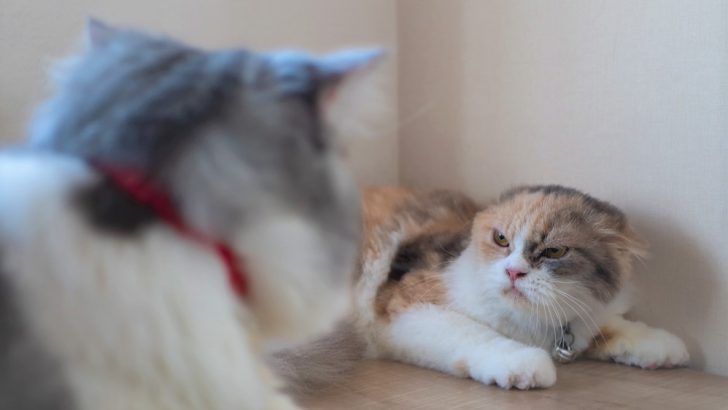I feel like I’m sharing these tips most of the time when someone visits our pet shop, yet I somehow forget to write them down. So, finally, today we’ll talk about warning signs when introducing cats that you should pay attention to.
We’re all familiar with the fact that cats are territorial beings. They’ll protect what’s theirs no matter the consequences. Because of this, when a new cat appears in the hood, it may be a bit tricky to control the situation. For that reason, I’ve prepared a detailed guide about introducing cats.
Being a cat parent can sometimes be stressful, especially in these situations. You don’t want to hurt your little resident fluff, but at the same time, you want to bring him or her new buddy. So how should you do it the right way? What do you have to pay attention to? Let’s find out together.
Warning signs when introducing cats that you should pay attention to
Let me make some things clear first. If two cats grew up together, you won’t have any problems, but if they didn’t, you have to pay attention to certain things. The most important warning signs when introducing cats are listed here.
Of course, before you dive deeper into this topic, you have to be aware of your resident cat’s behavior, weird habits, and preferences. When you know that, it will be easier to figure out how to approach her and react on time if she’s going to be the one causing problems.
So, let’s go.
1. Cats are staring at each other
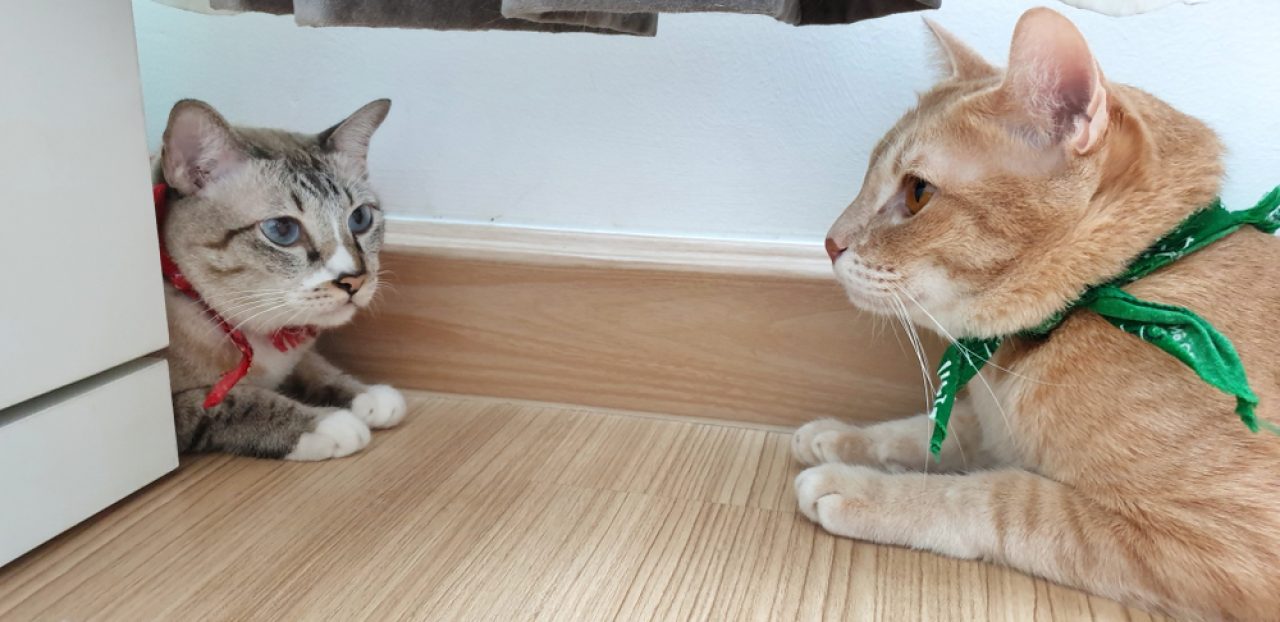
I think that everybody knows by now that cats are extremely curious beings. But, they’ll first observe carefully and then decide to react or approach. That’s what your resident feline will do as well when you adopt a new cat.
They may spend a decent amount of time quietly staring at each other because they feel uncomfortable or threatened. If you notice that they’re taking too much time, it’s possible that the aggression is building up and things may get nasty. Separate the cats as soon as possible to prevent possible disaster.
2. They’re growling and hissing
When cats start growling, it’s a clear sign that they’re uncomfortable, afraid, or in distress. Your feline may start producing these weird sounds because she feels upset and confused. But, generally speaking, the cat which feels more nervous will start growing first.
As soon as their fear levels rise, your furbabies start hissing at each other and producing that defensive sound. If you don’t react on time, this situation may escalate quickly.
3. They move their ears backward
The third warning sign when introducing cats would be this: cats move their ears backward or flatten them when they’re anxious, afraid, nervous, or threatened. So, if you notice that any of your cats pushed her ears back, know that they’re not feeling comfortable in the current situation.
When cats move their ears back and flatten them, they are getting ready to protect themselves from an external attack. In this case, either of the cats may be afraid that the other feline will attack and start fighting soon.
4. Their pupils are dilated
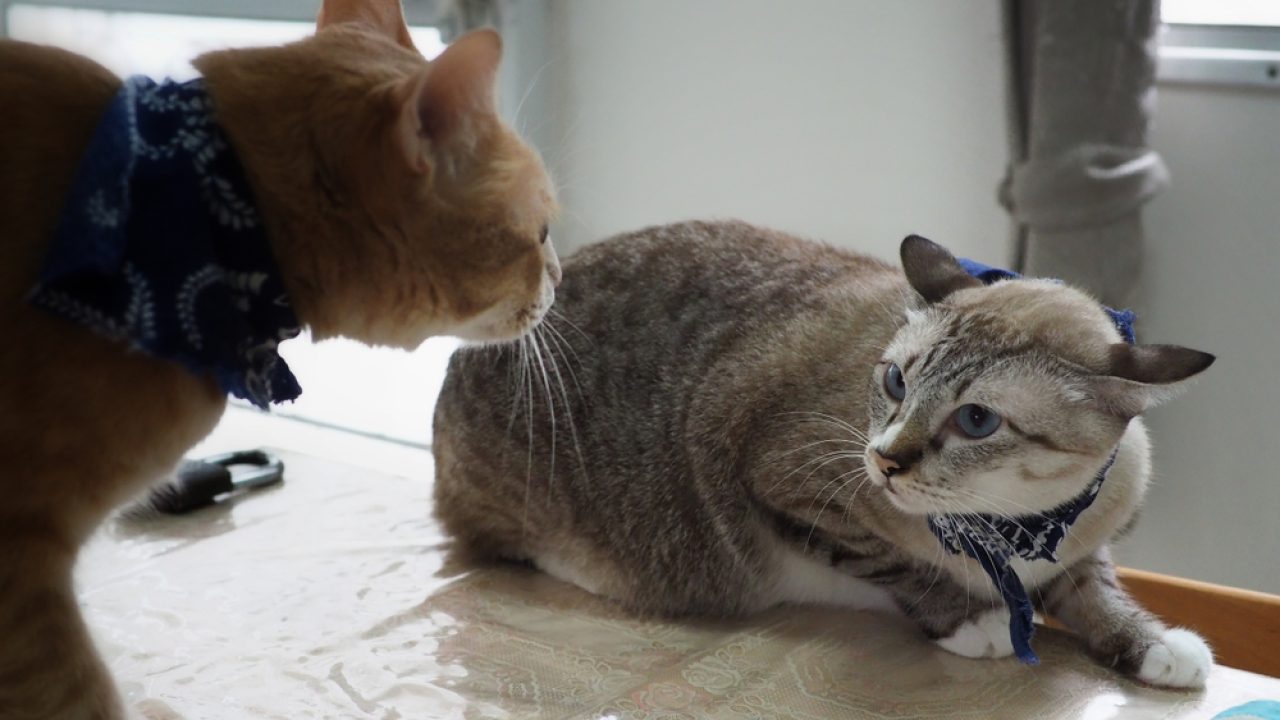
You know how our pupils dilate due to light or emotional changes, right? So, it’s kind of the same with our felines as well. When you notice that the black centers of her eyes are getting bigger you can be sure that your fluff is afraid and is about to get defensive.
Of course, if pupils don’t get back to normal soon, wait a bit more before you officially introduce them. I mean, right now it’s pretty obvious that at least one of them is not ready.
5. They may twitch their tails
Pay attention to those quick, sharp tail movements from right to left. Yes, it’s usually a sign of excitement, but it can also show that your feline is irritated or annoyed. Cat parents who have multiple felines living together stated this as one of the most common signs of an incoming storm.
So, if you notice those twitches, observe what’s happening and prepare yourself to react on time. This way you’ll be able to prevent the catastrophe.
6. They puff their fur and arch their backs
One of the most obvious warning signs that something weird is about to happen when introducing cats is when they puff their fur and arch their backs. I think we’re all familiar with this and I’m pretty sure you know what’s coming next.
Cats do this to appear bigger to their enemy and the one who’s afraid more, or the more insecure cat, will puff more. Even their tails will look bigger and fluffier to the point where you’ll ask yourself if it’s pawssible that they have so much hair.
7. One of them is hiding
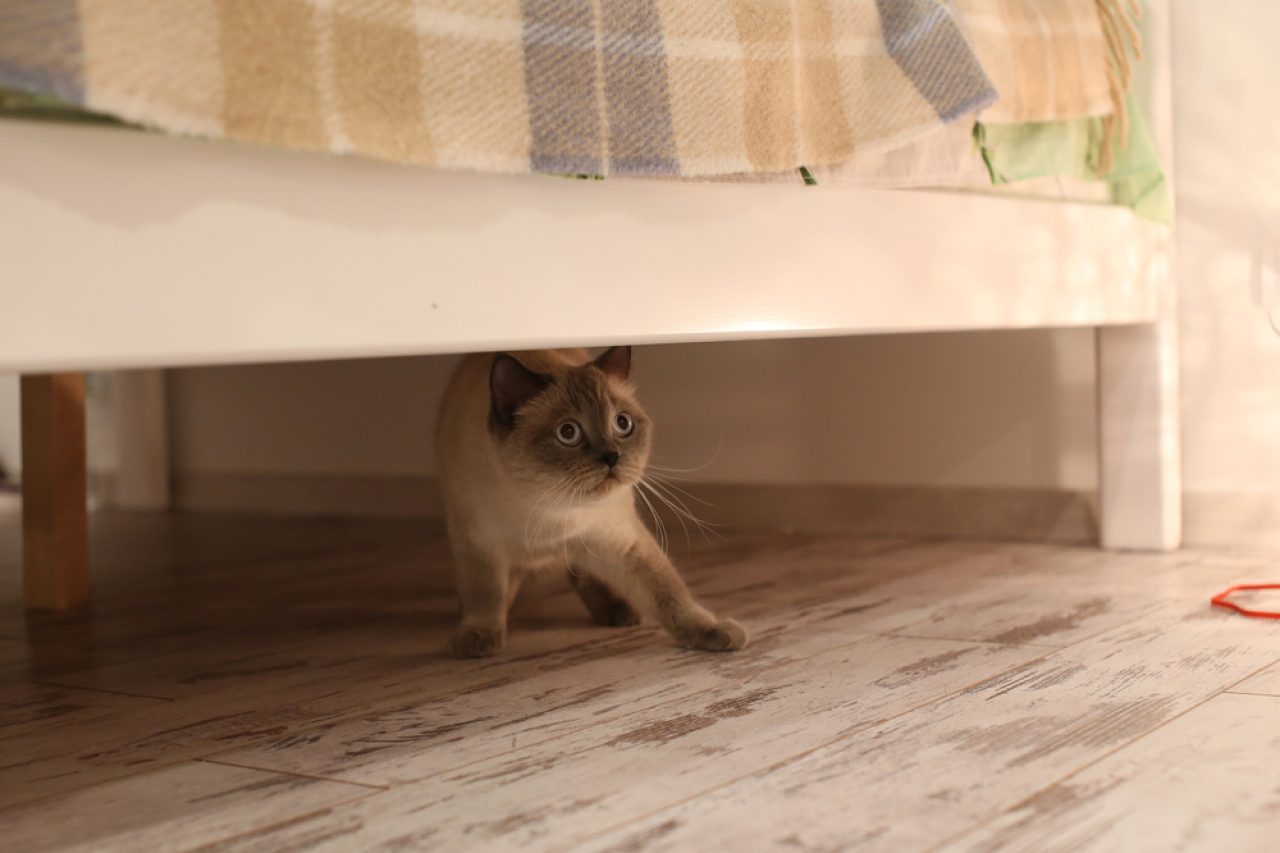
No, they’re not playing hide and seek. No matter how cute you think this behavior is, one cat is obviously pretty scared if she’s trying to find a hiding spot. She’ll go under the bed, or sofa, hide behind curtains or hop into the sink in the bathroom.
Sometimes your efforts in calling the scared cat back may be useless. Your new, less dominant cat, doesn’t want to leave her safe haven. If you find out where she is, separate them and spend some time with the hiding fluff.
She’s probably stressed because she started living in a new home and now there’s this crazy cat that’s chasing her around. Definitely not a place to be.
8. Resident cat’s snarling
Okay, this is one of the warning signs when introducing cats as well. It’s pretty similar to growling and hissing because your fluff is producing weird sounds as well. But, in this case, the sounds are high-pitched and way louder.
It’s a sign that your cat is not feeling comfortable in the company of the newcomer and she feels threatened a bit.
9. One of your cats (or both) is not eating
This is, in a way, a normal cat response when the situation is not right. It’s possible that your resident cat starts refusing her meals, especially if you’re feeding them in the same room. Serving her favorite treats won’t help either, so you’ll have to figure out something else.
Cats usually miss their meals if they have some underlying health issues, or when they’re stressed. In this case, the stressor is pretty obvious – it’s a new cat on the block.
10. One of them (or both) isn’t using the litter box
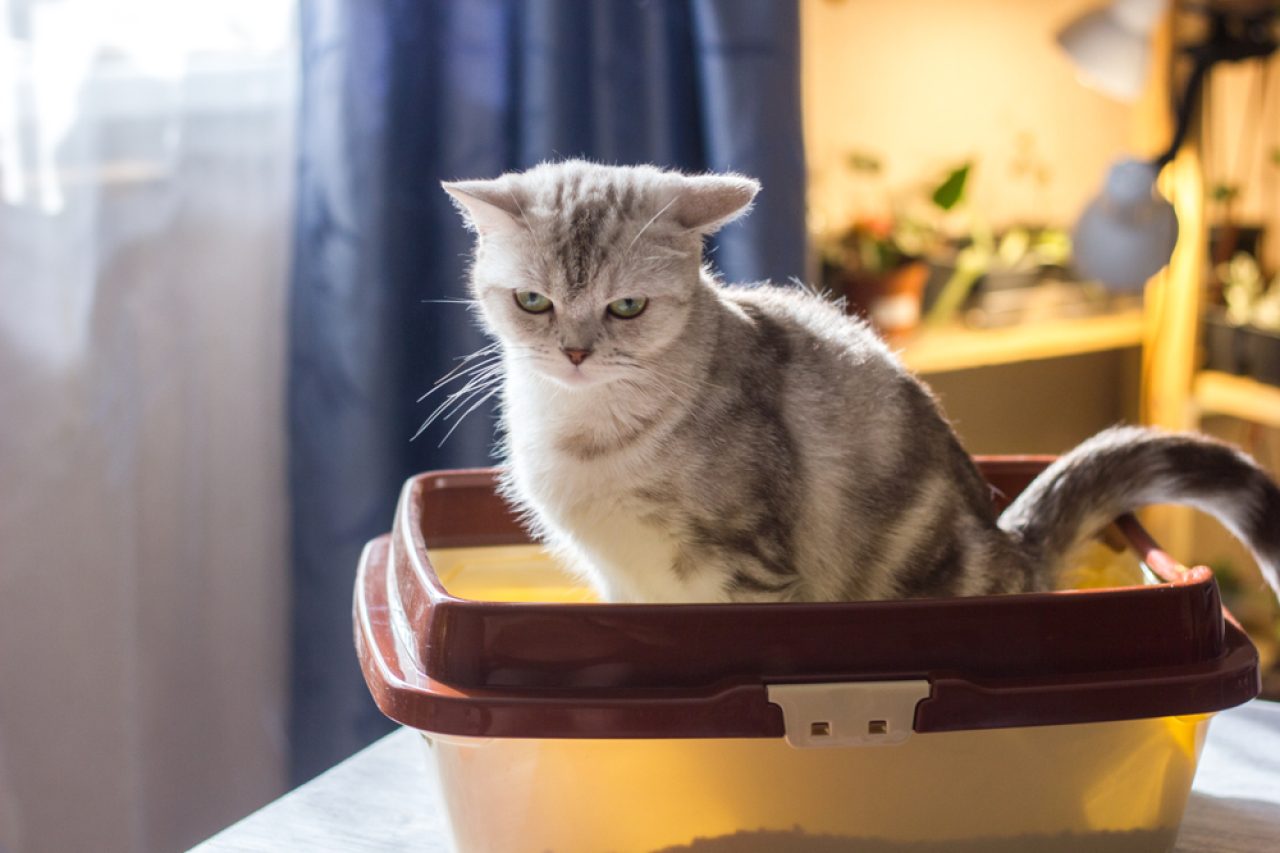
A simple change in their behavior means that something in their environment is not functioning properly. So, if your cat starts peeing or pooping outside her litter box, it’s definitely one of the warning signs that you should pay attention to when introducing cats.
Of course, if your fluff is not using the litter box there may be other problems as well, but we won’t talk about them right now.
11. Your resident cat is spraying her territory
Spraying her territory actually means that your resident cat will pee around the house to mark her space and make it clear to the newbie that she’s not the one to mess with. When cats are leaving the urine scent around, it clearly indicates that your furbaby is stressed and anxious about the new guest.
This way, she’s trying to put some boundaries with just a couple of drops of her pee on vertical surfaces. In some extremely rare situations, she may poo as well.
12. One of them (or both) is crouching
Cat’s body language will tell you everything, you just have to learn how to understand it. If any of your felines is crouching in the corner (or walking backward from a particular place), she probably feels threatened and the other fluff may be the problem.
Add flat ears to this and a locked gaze, while her tail is wrapped around her, she’s definitely getting ready for an attack. If you want to prevent bad things from happening, try to calm the situation down as soon as possible and simply separate the cats.
How to introduce cats the right way?
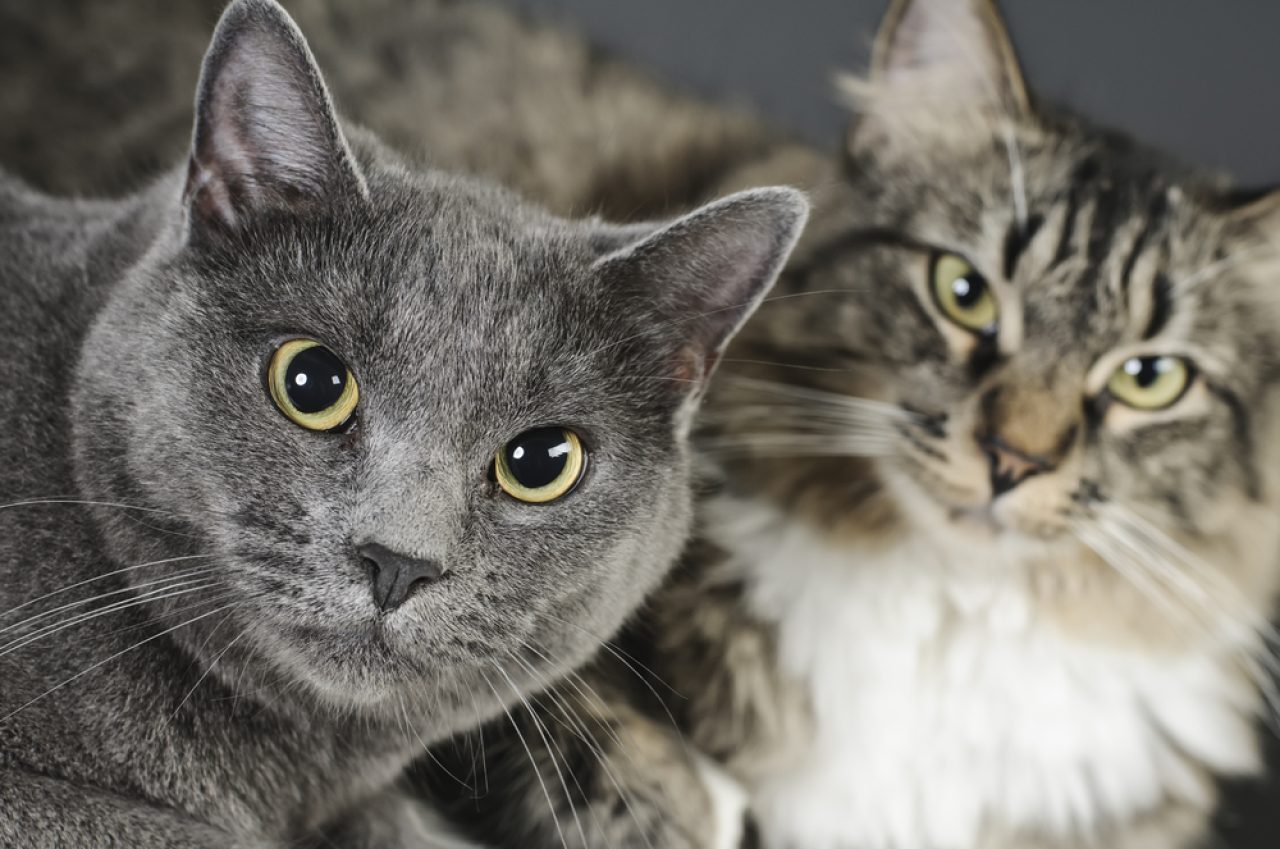
Now that you’re familiar with all the warning signs when introducing cats, it’s time to learn how to introduce them the right way. The most important thing is that you don’t rush anything since this is one of those situations that truly needs time to settle.
When you start thinking about adopting another cat, you have to think about a couple of things first. Do you have enough rooms in your household for both of them? How will you organize your time? What is your current cat’s personality? Does she have any behavioral problems?
I have to be completely honest with you. It’s not going to be easy. You also have to keep in mind that each cat is different, so some things may work, and others won’t necessarily be the ones you have to do. Since you’re the one directly observing the situation, I’m sure you’ll make the right call.
In the next part, I’ll try to explain to you one step at a time and try to ease this possible problem a bit. I hope you’re ready.
1. Keep them in separate rooms

This is one of the most important things that you have to enable them. Each feline has to have its own room, at least in the beginning. It’s really beneficial to keep them away at the start and introduce them to one another slowly.
Also, as soon as you notice some warning signs when introducing cats, you’ll be able to separate them and prevent any possible aggressive fights. The best option is to leave a new cat for a couple of days in her new room so she can adapt better.
This room should have all the essentials ready, so your new fluff should have her own bed, litter box, and food bowl. Ideally, you’ll also put a scratching post and a couple of toys that she can play with.
Moving out to a new home is awfully scary to felines. They go through a lot of stress and they may have problems figuring things out. Trust me, you don’t want to introduce her to the territorial resident cat that will intimidate her even more.
2. Introduce them by scent first
Obviously, both of them will be pretty aware that there’s another fluff in the room next door. In order to prevent the mess, you can let them explore each other’s areas, but under one condition. When your new fluff gets familiar with the new environment, swap their places.
For example, take the new fluff to the other room until your resident cat enters the room where the new one spent a couple of days. Once you close the door behind her, let the newbie explore the rest of the house.
This way, you’ll introduce them by scent first which means that they’ll get used to one another step by step. They’ll both understand that they’re sharing the territory with someone else.
You can also use towels or blankets that cats were using and swap them. They both may start hissing a bit and disapproving of your fishy move, but they’ll gradually get used to it.
3. Swap their food bowls

This should be done only when your cats are not reacting negatively to the scent of one another. So, when you notice that they’re either ignoring the object that you’ve changed or they simply sniff it and move away, that’s the right time.
It means that your furbabies got used to the presence of the scent of another cat and you’re ready to move to the next step. This time, try to swap their food bowls. If your cats refuse to eat, react immediately because you don’t want to maltreat them.
However, this could actually associate positive thoughts (I mean, who doesn’t like food?!) with the other cat’s scent. If the swapping goes without problems and they finish their meals, it means that your fluffs are ready to meet face to face.
4. Use a barrier when feeding them
We said to take it easy, so that’s how this process has to go. Before you officially introduce them, move their feeding bowls close to the room door of the new cat. Maybe they’ll avoid eating in the beginning and that’s completely fine.
In that case, move the bowls further from the door, because you don’t want them to starve. The next day, put them closer until there’s only the door between your fluffs. Once they get used to eating behind closed doors, switch to the see-through barrier, or leave the door open slightly.
They’ll be aware of each other’s presence, yet they won’t be able to physically interact. Afterward, reward them with some treats or a long playtime.
5. Play with them

For this step, you’ll need another person, since some of the warning signs when introducing cats may appear and you won’t be able to handle the situation alone if it escalates quickly. Ask your friend, partner, or family member to give you a hand.
Since the resident cat is probably comfortable being in their company, you should be the one picking up the new feline. Then, meet in the living room. Start with playing on the lap because chances are pretty high that neither of them will be too comfortable.
After a lot of cuddles, simply return them to their places and give them some treats because they surely deserved them.
6. Remove the barrier
When you notice that your cats are looking at one another, or trying to touch their noses through the see-through barrier, it’s time to remove the barrier completely. Be alert in case cats start showing some warning signs when the introduction officially starts.
In case they’re not moving toward each other right away, don’t force it. It’s really important that you don’t pick them up. They’ll meet and greet as they wish and when they wish to do so. It’s possible that some unpredictable situation happens, but just make a loud noise and catch them off guard.
7. Let them spend the night in the same room
This is the final step of the introduction and should be taken only when you’re completely sure that your felines are okay with each other. If everything goes well, you can relax. Your cats are obviously getting along well.
How to know if your cats are getting along?
From warning signs when introducing cats to your felines getting along well is a pretty long road. There are certain steps that need to be taken and the whole process can last from a couple of hours to a couple of months.
You have to be patient because hurrying things up won’t bring anything good. But, how can you know if your cats are getting along well? Here are the answers.
1. They’re grooming each other
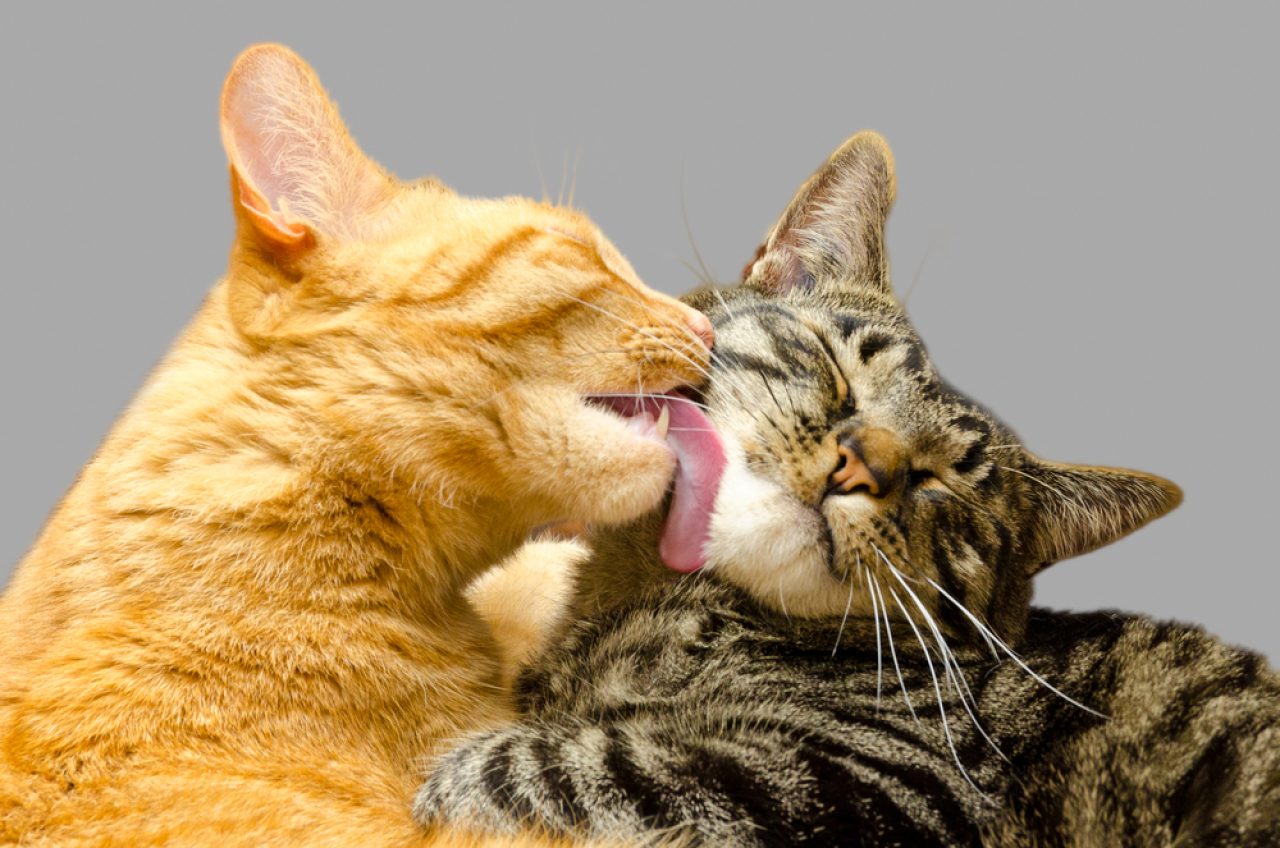
Grooming is the ultimate sign of trust and care between two cats, so if your two felines start grooming each other, you can rest assured that they’re on good terms. When they start helping one another stay clean, it officially means that they’re not strangers anymore.
2. They touch their noses
This is a simple way of greeting other cats in order to exchange scent information. They smell each other and this is basically the way cats communicate. You’re well aware that scent is really important to them, so if they trust each other to come that close, I’m sure they’re becoming very good friends.
3. They’re rubbing heads together
Do you remember how you felt special the first time your cat rubbed her head against you because it meant you were a part of the crew? So, if your furbabies are rubbing heads together, it means that they like each other.
This is actually an act of exchanging smells and a way of marking their territory.
4. They play together
I’ve got one question first. How do you know if kids get along well in kindergarten or on the playground? They play together and share toys, right? It’s the same with cats. As soon as they start playing together, you’ll know that you did a great job.
Whether your resident cat will share her favorite feather toy with a newcomer, or invite him to join her on a scratching post, it’s definitely a good sign and you shouldn’t be worried about any warning signs when introducing cats at this point.
5. They sleep together
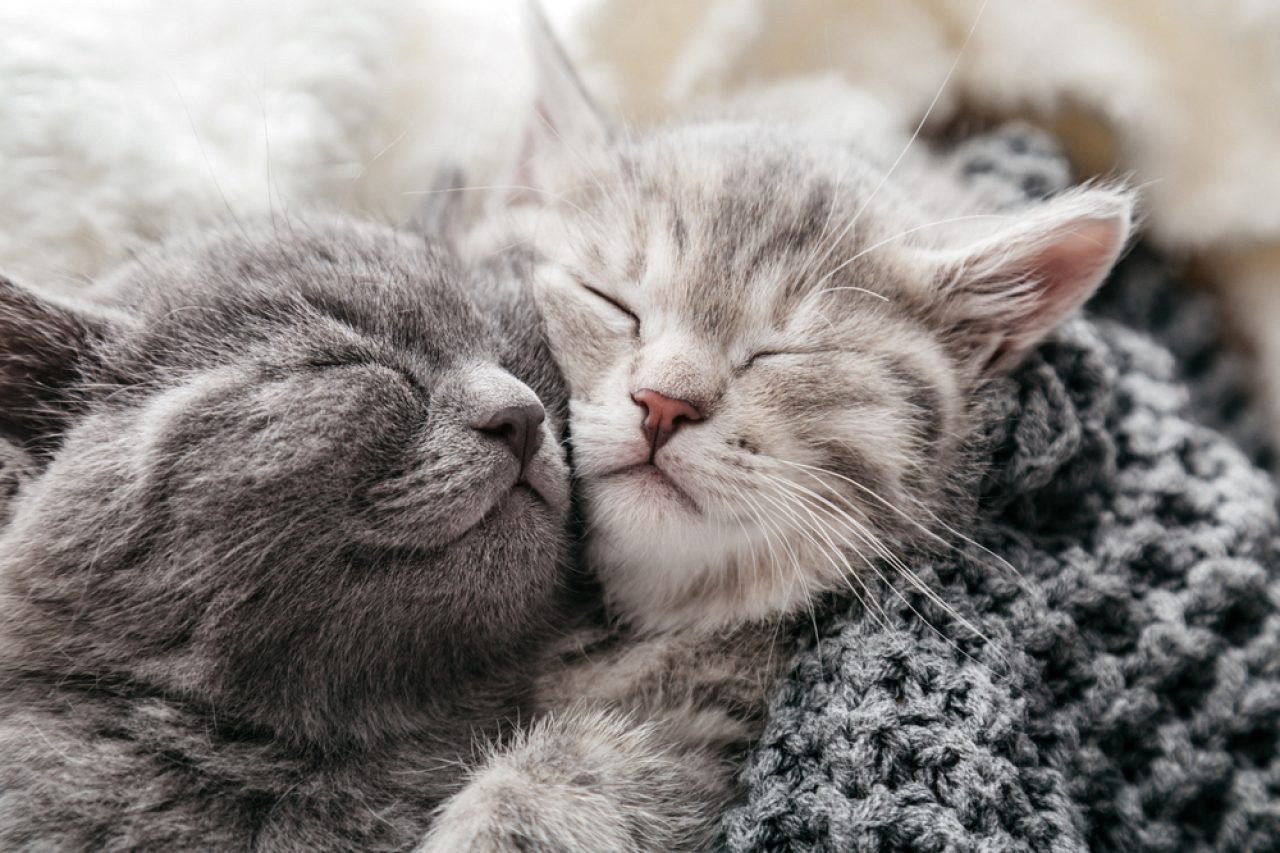
I’d say this is the ultimate sign of love. If your fluffs sleep together, it means that they trust each other and that they feel safe around one another. Cats are very vulnerable when they’re sleeping, so if they start sharing a bed, it’s a big deal.
They can also entwine their paws, or hug each other and that’s actually a crystal clear sign that they enjoy each other’s company.
6. They eat together
We all know that Joey doesn’t share food with strangers, and your fluff is the same. However, if your resident cat started sharing her meals with someone who was an intruder the other day, it’s obvious that they get along well.
Therefore, next time when you serve them a meal, try to put it in a bigger bowl so they can eat together without struggling.
Final words
After we went through all the warning signs when introducing cats, I hope you’re now ready to properly invite new fluff in the hood. Be careful not to do this unprepared since it’s actually a big deal.
You’re also aware of the bonding process between cats and how will you know if they like each other based on their behavior. If you follow this step-by-step guide on how to properly introduce cats, you shouldn’t have any problems.
I know it may seem easy, but the whole process requires a lot of time and patience, so have bucket-loads of them. You’ll have to try hard, but I’m sure you’ll make it. Good luck and have fun with your furbabies!

